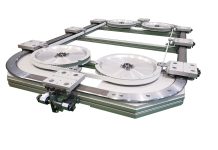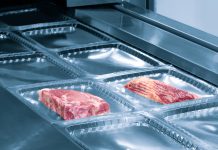 The trend is for pack that combines convenience, smaller portions and innovation. These consumer needs are confirmed by a recent IPSOS – International Consumer Research survey: the packaging convenience that the consumers appreciate most are: size, easy to handle and house storage, clear information, efficient protection, and finally easy to opening and re-closing. In the wake of these results, cheese producers are stressing smaller size containers with a wider opening to meet the single-serve market and ease of use and re-use. Rigid trays are brimming with benefits, they look modern, stand out on shelves and have a positive impact to the retailers always clamouring for shelf-ready packages. Cheese in trays have longer shelf life if packed in MAP. Controlled vacuum systems with gas injection bring to very low oxygen levels without knitting slices together. Many brands have now moved their thin and thick sliced cheese into rigid gas-flushed trays.
The trend is for pack that combines convenience, smaller portions and innovation. These consumer needs are confirmed by a recent IPSOS – International Consumer Research survey: the packaging convenience that the consumers appreciate most are: size, easy to handle and house storage, clear information, efficient protection, and finally easy to opening and re-closing. In the wake of these results, cheese producers are stressing smaller size containers with a wider opening to meet the single-serve market and ease of use and re-use. Rigid trays are brimming with benefits, they look modern, stand out on shelves and have a positive impact to the retailers always clamouring for shelf-ready packages. Cheese in trays have longer shelf life if packed in MAP. Controlled vacuum systems with gas injection bring to very low oxygen levels without knitting slices together. Many brands have now moved their thin and thick sliced cheese into rigid gas-flushed trays.
The tray is eye-catching packaging and an alternative to a flexible zippered package. It consists of a rigid bottom and a flexible lid sealed together. The tray, generally polypropylene, is thermoformed from a coextruded sheet with an oxygen barrier layer. The flexible film material of the lid is a multilayer coextrusion that also includes an oxygen barrier. The top is thermoformed of high-impact polystyrene. The lid can be easily peeled from the package by a pulling tab. The lid is usually a multilayer coextruded film (PP/PET or PP coex) that includes an oxygen barrier layer, the thickness can be between 200 – 500 μm. Peelable trays can be divided into two or more sections, each one closed with its lid, so the consumer can either remove the entire lid or only a part of it. Gas-flushed trays for cheese slices allow the modified atmosphere to be retained around the cheese. This improves the product shelf life, it has a positive effect on the product and flavour appearance and makes it easy the individual slice separation. In MAP, shelf life can be extended up to ten weeks. Sophisticated machineries flush out air from the packaging chamber and replace it with a correct defined mixture of gases, then seal the product in the packaging so that the product is maintained in a modified atmosphere environment. For soft cheese the appropriate atmosphere is a mixture of carbon dioxide and nitrogen; while for hard cheese an atmosphere of only carbon dioxide is more appropriate. During storage the carbon dioxide can dissolve into the water content of soft cheese and this reduces the volume of gas in the package, eventually causing the packaging to collapse. The presence of the nitrogen prevents this undesired effect. The flat surface of rigid trays provides unique product display options, direct printing or a adhesive label bearing store brand information can decor the lid while informative label with nutrition facts and other required information can take place on the tray bottom. Labels or marketing info always allow the consumer to see the whole product or at least part of it.
Assuming that when a package is convenient the consumers is more inclined to pay a little more, cheese packagers are investing in more innovative re-closable trays, consisting of three parts a clam shell container whose bottom is sealed by a lid. Sometimes the lid is snapped into a channel running around the perimeter of the tray. In the household use, once the flexible lid is removed the consumer can access to the product and then snap the top back in place to protect the remaining slices. The snap-on top is usually thermoformed.
Open and display
Being rigid, trays of cheese can be placed into retail-ready cases also in vertical position. The cases are thought both to ease the work of the retailer and to be eye-catching for the customer browsing in the store. The wraparound case, containing usually from ten to twenty items, are generally designed with a top and side ready to be ripped off without any effort over the opening for the retailer, the open cases are then ready to be placed on the store shelves. The stands up position, in the producer provided case or on the shelf, gives the opportunity to show at glance the characteristics and the distinctive features of the product to the consumers. As an additional feature: trays can also be hung on a peg or stacked flat in a well.
Cheese slicing and packaging are taken to a whole new level of speed and automation. With recent installations few people are required to operate from product infeed to palletizing and stretch wrapping of finished cases. Lines are designed with more servo motors resulting in quicker and more repeatable changeover and smaller footprint. Automatic thermoforming packaging solutions FFS start from a plastic film reel, the machine provides the finished package providing sealing and/or vacuum and MAP injection ready for secondary package. For smaller quantities the process starts from pre-formed trays. The flow chart can be simplified as: forming mould station, filling, vacuum unit, gas injection station, sealing station, cutting station and end line. By modular moulds the thermoforming station transforms the flat plastic film into trays, after cooling, a UV stations offer effective sterilization to the top and bottom films. Cheese logs are handled by robot arm equipped with vacuum suction cups toward cutting machine. After slicing, shingling, tray loading, and tray sealing are all done on automated lines. The sliced-cheese stacks are conveyed forward, while preformed trays are conveyed into position beneath the conveyor holding the stacks of cheese. As the conveyor holding the cheese retracts, each of the stacks of cheese slices drops a very short distance into the trays Then the cycle repeats itself. The trays move next into the evacuation/backflush chamber, according to product requirements nitrogen or other protective gases can be filled into the package after vacuumizing the unwanted gases. The modified atmosphere cycle is PLC controlled. Once the lid is applied, the trays move next into a station where the preformed top are automatically applied to the trays. Top can be snapped onto the tray flange or snapped into a channel running around the perimeter of the tray. A gating mechanism creates lanes of sealed, lidded trays and leads them to check weighing, contaminants detection (metal detector or x-ray), labelling, and date-coding. Trays of cheese are placed into retail-ready cases, sweep arms take trayed cheese packages and push them into a case. From there the cases are pushed forward so that flaps can be folded and adhesive applied. The wraparound cases are conveyed to a palletizer/stretch wrapper. Each time it forms a layer of cases, that layer is lowered onto a stretch wrapper turntable and a stretch film is applied.






